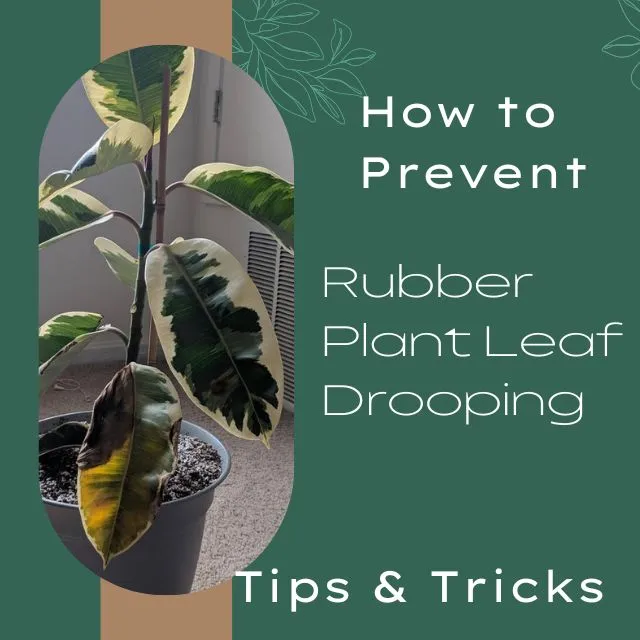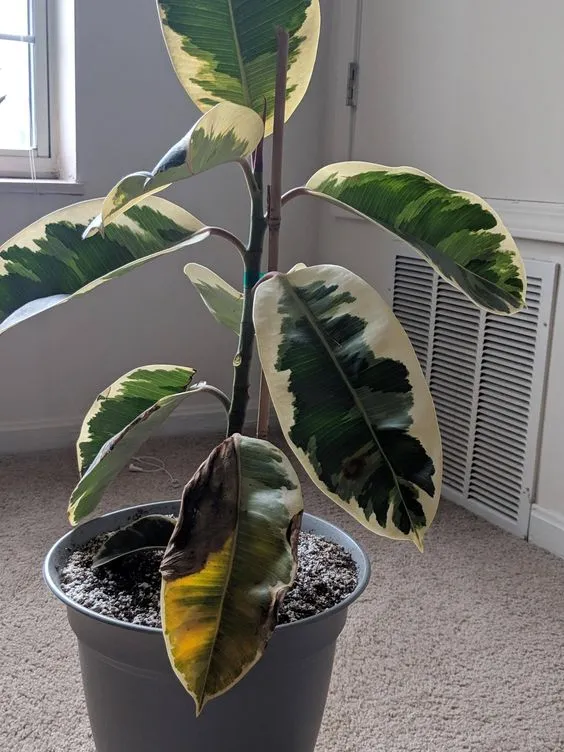Rubber plants (Ficus elastica) are popular houseplants known for their glossy, thick leaves and ability to thrive in various indoor environments. However, drooping leaves is one common issue that rubber plant owners may encounter.
Leaf drooping can indicate various problems, including overwatering, underwatering, pests, and environmental stress. In this article, we will explore the reasons behind rubber plant leaf drooping and what can be done to prevent and remedy this issue.

Symptoms of Rubber Plant Leaf Drooping
When a rubber plant’s leaves droop, it can be a sign of a health issue. The drooping leaves can look wilted or limp, and other symptoms, such as yellowing leaves or brown spots, may accompany them. In severe cases, the leaves may fall off the plant.
Causes of Rubber Plant Leaf Drooping
1. Overwatering
Overwatering is the most common cause of rubber plant leaf drooping. Rubber plants prefer to have their soil dry out slightly between waterings.
If the soil is consistently wet, it can lead to root rot, which can cause the leaves to droop.
To avoid overwatering, ensure your rubber plant is in a pot with good drainage. Only water your plant when the top inch of soil feels dry to the touch.
If you’re unsure when to water, stick your finger into the soil to test the moisture level.
2. Underwatering
Underwatering can also cause rubber plant leaves to droop. When a rubber plant is not watered enough, the leaves can become limp and droopy.
To avoid this issue, water your rubber plant regularly, allowing the top inch of soil to dry out before watering again.
3. Low Humidity
Rubber plants thrive in humid conditions, and low humidity can cause the leaves to droop. If the air in your home is dry, consider using a humidifier or placing a tray of water near your rubber plant to increase humidity levels.
4. Poor Lighting
Rubber plants require bright, indirect light to thrive. If your rubber plant is not receiving enough light, it can cause the leaves to droop.
Consider moving your plant to a brighter location or providing it with supplemental lighting.
5. Temperature
Rubber plants prefer warm temperatures between 60-75°F (15-24°C). If the temperature drops below this range, the leaves can become droopy.
Make sure to keep your rubber plant away from cold drafts and maintain a consistent temperature in your home.
6. Pests
Pests such as spider mites and mealybugs can also cause rubber plant leaves to droop. Check your plant regularly for signs of pests, such as webs or sticky residue, and take action immediately if you notice any.

Treating Rubber Plant Leaf Drooping
To treat rubber plant leaf drooping, identify the underlying cause and take appropriate action. Here are some steps you can take:
1. Watering
If your rubber plant is drooping due to overwatering, allow the soil to dry out before watering again. If it’s due to underwatering, give your plant a thorough watering and water it regularly in the future.
2. Humidity
If low humidity is causing your rubber plant’s leaves to droop, increase humidity levels by using a humidifier or placing a tray of water near the plant.
3. Lighting
If poor lighting is the issue, move your rubber plant to a brighter location or provide supplemental lighting.
4. Temperature
If the temperature is too low, move your rubber plant to a warmer location away from cold drafts.
5. Pests
If pests cause drooping leaves, use insecticidal soap or neem oil to treat the plant. Make sure to follow the instructions on the product label.
Preventing Rubber Plant Leaf Drooping
Preventing rubber plant leaf drooping requires taking steps to address the common causes of the issue. Here are some tips to help avoid your rubber plant’s leaves from drooping:
1. Watering
To prevent overwatering, make sure your rubber plant is in a pot with good drainage. Water your plant only when the top inch of soil feels dry to the touch.
Use a moisture meter or stick your finger into the soil to test the moisture level.
To prevent underwatering, establish a regular watering schedule and frequently check the soil moisture level. Make sure the top inch of the soil is dry before watering.
2. Humidity
Rubber plants prefer high humidity levels between 40-60%. You can increase humidity levels by using a humidifier, placing a water tray near the plant, or grouping plants. Avoid placing your rubber plant near air conditioners or heaters, which can dry out the air.
3. Lighting
Rubber plants need bright, indirect light to thrive. Place your rubber plant near a window that receives filtered sunlight, or provide supplemental lighting with a grow light if necessary. Avoid exposing your rubber plant to direct sunlight, which can scorch the leaves.
4. Temperature
Rubber plants prefer temperatures between 60-75°F (15-24°C). Avoid placing your plant near cold drafts or hot air vents. Keep the temperature in your home consistent by using a thermostat or regulating the indoor temperature.
5. Pests
To prevent pests, check your rubber plant regularly for signs of infestation. If you notice pests, isolate the plant immediately and treat it with insecticidal soap or neem oil.
Keep your rubber plant clean and free of debris to discourage pests from making a home on your plant.
By following these tips, you can help prevent your rubber plant’s leaves from drooping and keep your plant healthy and vibrant. Remember to monitor your plant and adjust your care as necessary to meet its needs.
Conclusion:
In conclusion, rubber plant leaf drooping can be a sign of a health issue that needs to be addressed promptly to prevent further damage.
The most common causes of drooping leaves are overwatering, underwatering, low humidity, poor lighting, temperature changes, and pests. To treat and prevent rubber plant leaf drooping, it’s essential to identify the underlying cause and take appropriate action, such as adjusting watering schedules, increasing humidity levels, providing adequate lighting, maintaining consistent temperatures, and treating pests. Following these steps can keep your rubber plant healthy and thriving.
Also Read: All About Hawaiian Spider Plants: Care, Propagation & Problems
